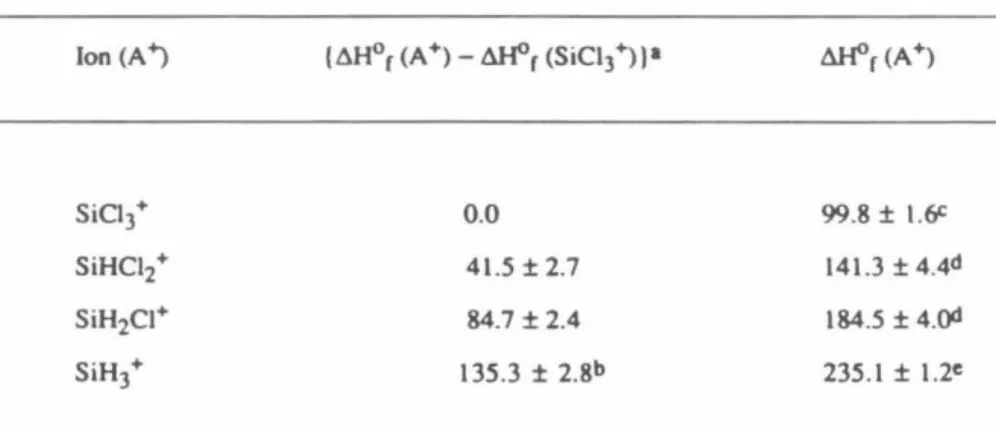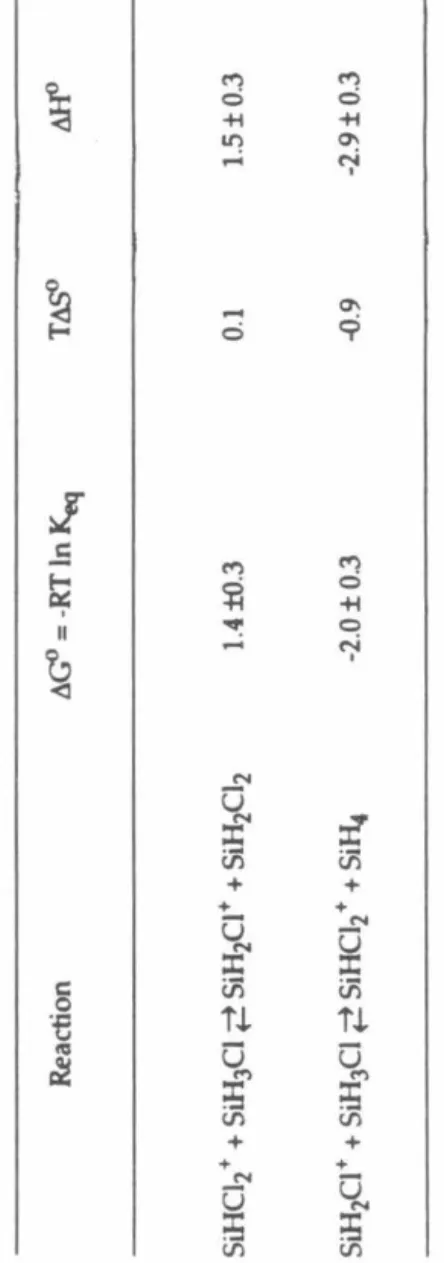Examination of ion-molecule reactions in chlorosilanes by FT-ICR spectrometry and determination of the relat. Armentrout and co-workers have applied the directed ion beam technique15,16 to studies of ion-molecular reactions of tetrachlorosilane. It was therefore important to determine the relative hydride and chloride affinities of the chlorosilyl ions.
The enthalpy of reaction 17 was also calculated from available literature data sets for the heats of formation of neutral chlorosilanes. The H or Cl affinities of the chlorosilyl ions were used in conjunction with the heats of formation of neutral chlorosilanes and Equation 18 to obtain the relative heats of formation of the chlorosilylene.
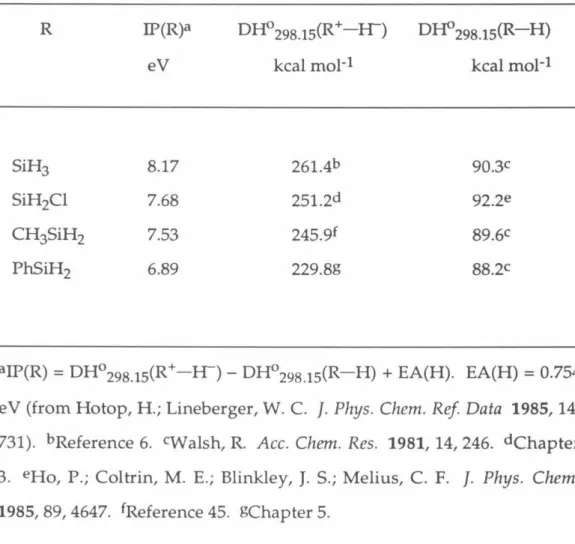
FT -ICR Spectrometric Studies of the Gas Phase Ion Chemistry of Phenylsilane
The yield of the unreactive C6SiH7+ isomer as a function of the electron impact ionization energy corresponds to the yield of the unreactive C7H7+ isomer. Unlike toluene, which gives only C7H7+ structural isomers on ionization, phenylsilane gives structural isomers of C6SiH8+ and. Theoretical calculations indicate that it is the most stable of the three isomeric forms of the C6SiH6+ cations.
One of the structural isomers transfers a SiH2 + moiety to C6D6 indicating that it has the structural form represented by either IVa or IVb. Summary of previous studies of the gas-phase ion chemistry of substituted silanes and related systems.
Summary of Previous Studies of the Gas Phase Ion Chemistry of Substituted Silanes and Related Systems
Recently Lampe and co-workers38 have used the molecular beam photoionization mass spectrometry technique to obtain the heats of formation of SiH0 + (n= 2-3) and the ionization potentials of SiHn (n= 2-3). Ion-molecule reactions in disilane were studied by Lampe and co-workers.40 Mandich and Reents31 studied ion-molecule reactions in water-disilane mixtures. Lim and Lampe46 as well as Armentrout and co-workers47 have examined the reactions of Si+ with methylsilane.
Jacobson and colleagues SO have looked at the reactions of SiHx(CH3b-x + (x = 1-3) with propene and 2-methylpropene. Reactions of Si+ with SiF4 have been studied by Armentrout and colleagues.52 Bohme and co-workers have studied the reactions of Si+ with a number.
Chapter II
Where possible, the relative Cl and Ir affinities of the chlorosilyl ions have been determined quantitatively. Such stabilities are usually described by the x-affinity, D(R+ .. simulation of the reaction kinetics.
The rate constant of reaction 16 was obtained from numerical simulations of experimental data after initial isolation of SiHCl2. As evidenced by Figure Sa, it is important to consider reaction 8 in the analysis of the results. While this prevents the determination of quantitative differences between the I-r affinity values of SiH3.
Based on these observations, the Cl- and H- affinity order of the chlorosilyl ions is given by the sequences 42 and 43, respectively. The mean enthalpy of reaction 44 calculated from the H M data set 27 is in excellent agreement with the current experimental result. For these reasons, the HM data set is used to obtain the values of the relative heats of formation of chlorosilyl ions, as shown in Table 4.
The 1t system, perpendicular to the plane of the ion, contains one bonding, two nonbonding, and one antibonding orbital. The enthalpy of reaction 49 calculated from the relative heats of formation of chlorosilyl ions determined in this study is 1.7 ± 8.0 kcal mol-l. When the reactants collide, an intermediate complex of chloronium ions, [H3Si- Cl - SiC13]+ (III), will probably be formed.
First, it is almost impossible to systematically control the total energy of the reacting partners. The ion–molecular reactions of silyl and chlorosilyl ions with chlorosilanes and chlorosilyl ions with silane were reported and discussed for the first time.
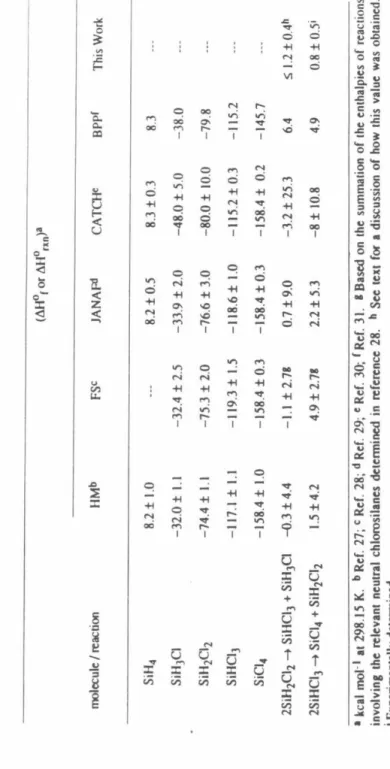
Chapter III
Gas phase positive ion chemistry in SiH3Cl is investigated by the technique of Fourier Transform Ion Cyclotron Resonance Spectrometry. Reaction pathways and rate constants for the reactions of SiHnC13-n + (n = 1-3) with SiH3Cl were obtained. Within experimental uncertainty, the values of the H- affinities of the chlorosilyl ions lie within 1.8 kcal moi-l of each other and decrease in the order SiH2Cl+.
The ionization potential of SiH2Cl was determined in eV and its heat of formation at room temperature was determined in kcal moi-l. Protonated SiH3Cl is formed by proton transfer from CHs + and is observed to be stable at room temperature over the time frames of our experiment.
Introduction
The values and order of the relative stabilities of the chlorosilyl ions show striking differences from those of the halogen methyl ions. The non-inclusion of smaller reaction channels in the simulation of the reaction kinetics further contributes to the error in the rate constants. Calculation of the enthalpy of reaction 1 using the heats of formation of the relevant species shown in Table 2 indicates that reaction 1 is exothermic by kcal mol-l.
For example, reaction 1 is likely to proceed through the formation of the disilylchloronium ion, (5iH3hCl+, intermediate. From the rate constant of reaction 4 obtained in this study and the rate constant of the reverse reaction previously obtained, Keq = kf/kr for is calculated as process 5. Previously, the non-observation of reaction 9 in mixtures of SiH4 and SiHC13 was taken as an indication of the W-affinity of SiC13 + being.
The present results support the Ir affinities of the chlorosilyl ions to be ordered as shown in series 10. From the heat of formation of the chlorosilanes listed in Table 2, the enthalpy of reaction 11 is calculated to be -2.2. In SiH3, the orbital occupied by the unpaired electron does not interact with the other filled orbitals of the radical.
Removal of this unpaired electron results in an empty 3p orbital in the positively charged silicon center of the SiH3 + cation. Removal of this unpaired electron results in an empty 3p orbital in the positively charged silicon center of the SiH2Cl + cation. The formation of the fluoronium ion, [(CH3)3SihF+ has previously been observed27 to occur via reaction 16.
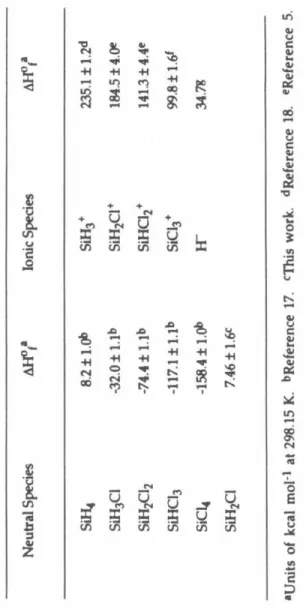
Conclusions
Therefore, it is observed to be stable over the time scales of typical ICR experiments (1–1000 msec).
Acknowledgments
Fourier transform ion cyclotron resonance studies of the ion–molecule reactions of C 6SiH7 + (formed by electron impact ionization of phenylsilane) with the parent neutral indicate that it contains reactive and unreactive populations. The variation with electron impact energy of the relative yields of reactive and unreactive C6SiH7 + isomers of phenylsilane exhibits a behavior that is qualitatively similar to the relative yields of reactive (benzyl) and unreactive (cycloheptatrienyl) C 7H 7 + isomers of toluene. Since the original proposal by Mayerson and co-workers that hydrogen atom loss from the molecular toluene cation leads to the formation of the cycloheptatrienyl cation (Ia), a number of studies2 have attempted to elucidate the structure, energetics and modes of formation of C7H7. + isomers.
The relative yields of both isomers depend on the internal energy content of the molecular toluene cation. 2a,f,i,j,m,n. Interestingly, ion Fourier transform cyclotron resonance spectrometry3 studies in our laboratory of the reactions of C6SiH7 + (formed by electron impact ionization of phenylsilane) with the parent neutral element show that this ion can form in two isomeric forms, which at room temperature they are not mutually exclusive. . Isolation of C6SiH7 + formed by electron impact ionization of phenylsilane in the same mixture of phenylsilane and CH3F shows that the C6SiH7 + fraction that is unreactive with phenylsilane is also unreactive with CH3F, while the reactive fraction C6SiH7 + undergoes both reactions 1 and 5.
Figure 2 shows that the non-reactive isomer C 6SiH7 + , which is the dominant product at electron energies below 14 eV, monotonically decreases until the ratio between non-reactive and reactive isomers reaches a constant value of -0.5 at electron energies higher than 20 eV. This leads us to assume that the non-reactive isomer C6SiH7 + is the silacycloheptatrienyl cation (lb. The fraction of the non-reactive isomer C6SiH7 + is defined as the ratio between the abundance of C6SiH7 + in the dynamic equilibrium state (measured during msec) and the abundance of C6SiH7 + measured 5 ms after the electron beam pulse .
Further studies are underway in our laboratory to quantitatively determine the relative stability of the C6SiH7. One of the authors (Y. N.) gratefully acknowledges financial support from the Yamada Science Foundation of Japan for a visiting associateship at Caltech. In Mass Spectrometry of Organic Ions; McLafferty, F. 3) (a) The technique of ion cyclotron spectrometry and its chemical applications is discussed in Beauchamp, J. b) FT-ICR spectrometry is reviewed in Marshall, A. 5) Average of the values listed in Lias, S. Thermochemical properties and gas-phase ion chemistry of phenylsilane by FT-ICR.
Abstract
It has been found that the H-affinity of the silacycloheptatrienyl cation is lower than that of the cycloheptatrienyl cation. However, the intensity of each of these ions was less than 1% of the total ion signal. The variation with electron impact energy of the yield of the unreactive C6H 6Si+ isomer is shown in Figure 4.
Interestingly, this behavior is in contrast to that observed in the case of the C6H 6Si+ ion, in which the abundance of. Temporal variations of the C6H8Si+ ion and other reaction product ions are shown in Figure 5(b). The formation of an ion of m/z = 139 is observed after the isolation of the C6D 6H2Si+ ion.
It is therefore surprising that the hydride affinity of the silacycloheptatrienyl cation is less than 194 kcal moi-l. In this study, we observe the production of two reactive isomers and one non-reactive isomer of the C 6H6Si+ ion by electron impact ionization of phenylsilane. In the case of reactive isomeric ions C6H6Si+, it was suggested that the ion participating in the Si+ transfer reaction is the complex ion Si+- C6H6 (2a).
Therefore, it is likely that the disordered structure of the molecular ion (4c) should be formed upon ionization of phenylsilane. The electron affinity of the hydrogen atom, EA(H), was previously measured to be 0.754 eV17. Furthermore, in the case of silicon ions, DH029s(R+-H-) is linearly correlated with IP(R) within the experimental uncertainty.
Variation of the percentage of unreactive C6H 6Si+ (2c) and C 6H 7Si+ (3c) isomeric ions as a function of electron impact energy of phenylsilane at a pressure of 7.9 x 10-8 Torr. The width of the electron beam pulse was 20 ms. a) Temporal variation of ion abundances after the isolation of C6H 6Si+ in a 1:1.4 phenylsilane/benzene-d6 mixture maintained at a total pressure of 1.9 x 1Q-7 Torr.
